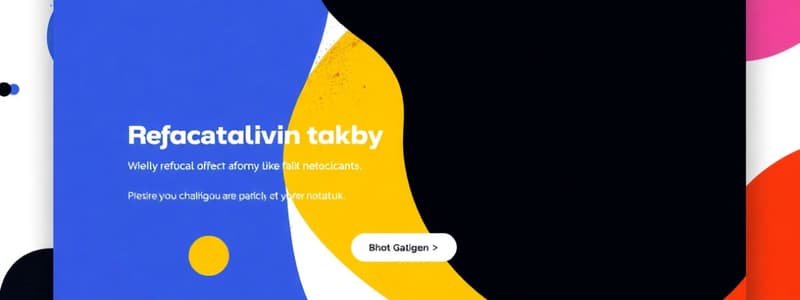Podcast
Questions and Answers
What is the primary function of the rising action in a story?
What is the primary function of the rising action in a story?
- To unfold the central conflict and build anticipation (correct)
- To wind down the story after the climax
- To resolve the central conflict
- To introduce the hero and their challenges
What occurs during the climax of a narrative?
What occurs during the climax of a narrative?
- The central conflict reaches its highest point of intensity (correct)
- Loose ends are tied and minor characters are introduced
- Characters begin to face their challenges
- The story hints at the eventual resolution
What character role assists the hero on their transformative journey?
What character role assists the hero on their transformative journey?
- The bystander
- The helper (correct)
- The challenger
- The antagonist
Which part of the story involves tying up loose ends after the climax?
Which part of the story involves tying up loose ends after the climax?
What is the main benefit of using storyboards in design?
What is the main benefit of using storyboards in design?
What does the term 'voice' refer to in UX design?
What does the term 'voice' refer to in UX design?
How does storytelling contribute to business demonstrations?
How does storytelling contribute to business demonstrations?
Which type of story is primarily aimed at motivating the audience?
Which type of story is primarily aimed at motivating the audience?
What is the primary function of storyboards in UX design?
What is the primary function of storyboards in UX design?
In what way does 'tone' differ from 'voice' in UX design?
In what way does 'tone' differ from 'voice' in UX design?
Why is it important for the voice to be consistent across all touchpoints of a brand?
Why is it important for the voice to be consistent across all touchpoints of a brand?
What aspect of a brand does voice help to reflect according to UX design principles?
What aspect of a brand does voice help to reflect according to UX design principles?
What is the primary goal of adapting tone based on user context?
What is the primary goal of adapting tone based on user context?
Which tone is most appropriate during error messages?
Which tone is most appropriate during error messages?
What does the 'Less is More' principle emphasize?
What does the 'Less is More' principle emphasize?
Which tone should be used during onboarding and welcome messages?
Which tone should be used during onboarding and welcome messages?
In what scenario should a tone convey security and reliability?
In what scenario should a tone convey security and reliability?
What principle does the action- and goal-oriented communication principle emphasize?
What principle does the action- and goal-oriented communication principle emphasize?
How should support and help documentation be written?
How should support and help documentation be written?
Which tone is appropriate for feedback and user surveys?
Which tone is appropriate for feedback and user surveys?
What is a key benefit of adapting tone for different scenarios?
What is a key benefit of adapting tone for different scenarios?
What does authenticity in a brand's voice and tone ensure?
What does authenticity in a brand's voice and tone ensure?
Why is consistency important in a brand's voice and tone?
Why is consistency important in a brand's voice and tone?
How should a brand's voice and tone handle diverse contexts?
How should a brand's voice and tone handle diverse contexts?
What does relevance in a brand's voice and tone signify?
What does relevance in a brand's voice and tone signify?
What is the main benefit of storytelling in UX design?
What is the main benefit of storytelling in UX design?
How do personas contribute to business demos?
How do personas contribute to business demos?
What aspect do effective personas highlight in business stories?
What aspect do effective personas highlight in business stories?
What role does action-orientedness play in a brand's communication?
What role does action-orientedness play in a brand's communication?
What is a primary use case for storytelling in UX design?
What is a primary use case for storytelling in UX design?
Why is clarity important in a brand's communication?
Why is clarity important in a brand's communication?
What role do personas play in user journey visualization?
What role do personas play in user journey visualization?
Which type of story is designed to convey specific product-related information?
Which type of story is designed to convey specific product-related information?
What are the 3 Rs that make inspirational stories impactful?
What are the 3 Rs that make inspirational stories impactful?
How does storytelling enhance user engagement?
How does storytelling enhance user engagement?
Which part of a story arc introduces the setting and background information?
Which part of a story arc introduces the setting and background information?
What is NOT a use case for storytelling in UX design?
What is NOT a use case for storytelling in UX design?
What type of stories foster emotional connections by showcasing real challenges?
What type of stories foster emotional connections by showcasing real challenges?
Which aspect of storytelling helps simplify complex ideas?
Which aspect of storytelling helps simplify complex ideas?
What characteristic is NOT associated with effective informational stories?
What characteristic is NOT associated with effective informational stories?
What is a primary benefit of using personas during design iterations?
What is a primary benefit of using personas during design iterations?
Flashcards
Voice in UX
Voice in UX
The personality, style, and brand identity conveyed through the content and interactions of a digital product or service.
Tone in UX
Tone in UX
The tone reflects the overall mood, formality, and level of engagement. It can be casual, formal, playful, serious, or any combination of these.
Real Life Stories
Real Life Stories
Stories based on real events, either personal or professional, offering insights into genuine challenges and outcomes.
Inspirational Stories
Inspirational Stories
Signup and view all the flashcards
Informational Stories
Informational Stories
Signup and view all the flashcards
Storyboarding
Storyboarding
Signup and view all the flashcards
Business Demo Storytelling
Business Demo Storytelling
Signup and view all the flashcards
Action-Oriented Content
Action-Oriented Content
Signup and view all the flashcards
Less is More in UX
Less is More in UX
Signup and view all the flashcards
Accessible and Approachable Content
Accessible and Approachable Content
Signup and view all the flashcards
Tone in Transactions
Tone in Transactions
Signup and view all the flashcards
Tone in Feedback
Tone in Feedback
Signup and view all the flashcards
Tone in Help Documentation
Tone in Help Documentation
Signup and view all the flashcards
Tone in Onboarding
Tone in Onboarding
Signup and view all the flashcards
Tone in Error Messages
Tone in Error Messages
Signup and view all the flashcards
Brand Voice Authenticity
Brand Voice Authenticity
Signup and view all the flashcards
Brand Voice Consistency
Brand Voice Consistency
Signup and view all the flashcards
Brand Voice Clarity
Brand Voice Clarity
Signup and view all the flashcards
Brand Voice Flexibility
Brand Voice Flexibility
Signup and view all the flashcards
Brand Voice Relevance
Brand Voice Relevance
Signup and view all the flashcards
Brand Voice Action-Orientedness
Brand Voice Action-Orientedness
Signup and view all the flashcards
Storytelling in UX
Storytelling in UX
Signup and view all the flashcards
Benefits of Storytelling in UX
Benefits of Storytelling in UX
Signup and view all the flashcards
Humanizing Users with Personas
Humanizing Users with Personas
Signup and view all the flashcards
Building Empathy with Personas
Building Empathy with Personas
Signup and view all the flashcards
Climax
Climax
Signup and view all the flashcards
Rising Action
Rising Action
Signup and view all the flashcards
Falling Action
Falling Action
Signup and view all the flashcards
Victory
Victory
Signup and view all the flashcards
Helper
Helper
Signup and view all the flashcards
What are personas used for?
What are personas used for?
Signup and view all the flashcards
How can personas support design?
How can personas support design?
Signup and view all the flashcards
What are 'real-life stories' in UX?
What are 'real-life stories' in UX?
Signup and view all the flashcards
What are 'inspirational stories' in UX?
What are 'inspirational stories' in UX?
Signup and view all the flashcards
What are 'informational stories' in UX?
What are 'informational stories' in UX?
Signup and view all the flashcards
What are the benefits of storytelling in UX?
What are the benefits of storytelling in UX?
Signup and view all the flashcards
What is the 'exposition' in a story arc?
What is the 'exposition' in a story arc?
Signup and view all the flashcards
How does storytelling communicate purpose in UX?
How does storytelling communicate purpose in UX?
Signup and view all the flashcards
How can storytelling make complex concepts accessible?
How can storytelling make complex concepts accessible?
Signup and view all the flashcards
How does storytelling build brand identity in UX?
How does storytelling build brand identity in UX?
Signup and view all the flashcards
Study Notes
UX Fundamentals - Corporate Branding and Styling
- Distinguish between 'voice' and 'tone' in UX design
- Understand their separate roles in impacting user interaction
- Employ storytelling elements to construct compelling customer narratives
- Gain insights into storyboards, their visual communication of design concepts
- Understand storytelling's role in impactful business demos
- Voice reflects personality, style, and brand identity
- Brand character consistently expresses brand values to connect with users
- Consistent experience ensures cohesive content across all touchpoints
- Tone refers to the mood or attitude expressed in content and interactions
- Tone adapts based on context (e.g. friendly onboarding, professional support)
- Communication principles aim to make content accessible, effective, and concise
- Action and goal-oriented content directs users toward specific objectives
- Brief and concise content avoids overwhelming users
- Content should be accessible and approachable to diverse audiences
- Tone should be adaptable, based on user context, to enhance empathy/understanding
- Transactional interactions (e.g. online purchases) should convey security and reliability
- Positive feedback mechanisms, like user surveys, can shape product development
- Support materials (e.g. instructions, documentation) should be clear and easily accessible
- Onboarding messages should motivate engagement with key features
- Error messages should be helpful and empathetic
- Key principles for brand voice & tone include authenticity, consistency, clarity, and flexibility
- Relevant tone aligns with audience expectations
- Action-oriented language motivates engagement with a clear ‘call to action’
- Storytelling in UX design creates user connections through narratives and visuals
Types of Stories
- Real Life Stories: showcase real challenges and successes
- Inspirational Stories: inspire/motivate with examples of overcoming adversity
- Informational Stories: convey information/features about the product
- Use Cases: communicating purpose, making complex ideas accessible, building brand identity, and creating memorable experiences
Visual Representation of the Design Process
- Storytelling enhances user engagement and fosters empathy
- Storyboards are valuable for onboarding, guiding users, and demonstrating product value
- Storyboards enhance stakeholders’ understanding of design and their support
- Using personas in business stories establishes user empathy and relatability
Storyboarding
- Storyboarding process involves visually sketching interactions
- Whiteboarding steps visualize interactions and facilitate collaboration
- Mapping elements and user journeys clearly enables comprehension
- Mocking up screens with Google Slides allows for rapid prototyping and feedback gathering
- Building a demo visualizes design and identifies difficult design issues
- Storyboarding enables communication, iterative design, issue identification, and cost/time savings
Studying That Suits You
Use AI to generate personalized quizzes and flashcards to suit your learning preferences.




